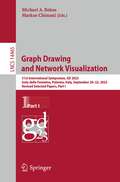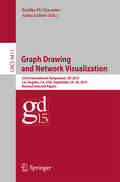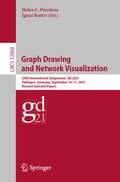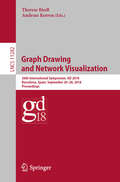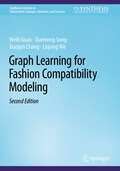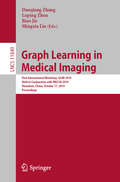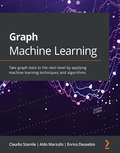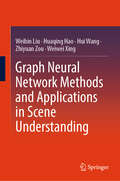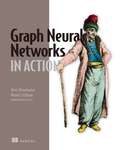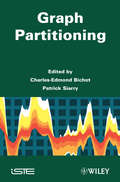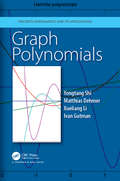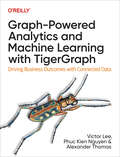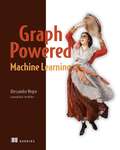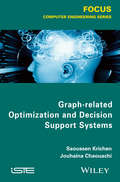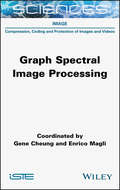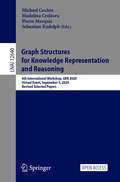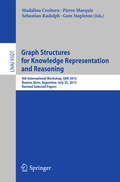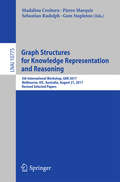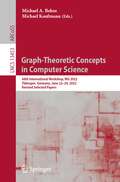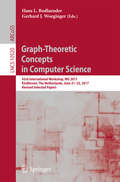- Table View
- List View
Graph Drawing and Network Visualization: 31st International Symposium, GD 2023, Isola delle Femmine, Palermo, Italy, September 20–22, 2023, Revised Selected Papers, Part I (Lecture Notes in Computer Science #14465)
by Michael A. Bekos Markus ChimaniThis two-volume set LNCS 14465-14466 constitutes the proceedings of the 31st International Symposium on Graph Drawing and Network Visualization, GD 2023, held in Isola delle Femmine, Palermo, Italy, in September 2023. The 31 full papers, 7 short papers, presented together with 2 invited talks, and one contest report, were thoroughly reviewed and selected from the 100 submissions. The abstracts of 11 posters presented at the conference can be found in the back matter of the volume. The contributions were organized in topical sections as follows: beyond planarity; crossing numbers; linear layouts; geometric aspects; visualization challenges; graph representations; graph decompositions; topological aspects; parameterized complexity for drawings; planar graphs; frameworks; algorithmics.
Graph Drawing and Network Visualization: 25th International Symposium, GD 2017, Boston, MA, USA, September 25-27, 2017, Revised Selected Papers (Lecture Notes in Computer Science #10692)
by Fabrizio Frati Kwan-Liu MaThis book constitutes revised selected papers from the 25th International Symposium on Graph Drawing and Network Visualization, GD 2017, held in Boston, MA, USA, in September 2017.The 34 full and 9 short papers presented in this volume were carefully reviewed and selected from 87 submissions. Also included in this book are 2 abstracts of keynote presentations, 16 poster abstracts, and 1 contest report. The papers are organized in topical sections named: straight-line representations; obstacles and visibility; topological graph theory; orthogonal representations and book embeddings; evaluations; tree drawings; graph layout designs; point-set embeddings; special representations; and beyond planarity.
Graph Drawing and Network Visualization
by Emilio Di Giacomo Anna LubiwThis book constitutes the proceedings of the 23rdInternational Symposium on Graph Drawing and Network Visualization, GD 2015,held in Los Angeles, Ca, USA, in September 2015. The 35 full papers presented together with 7 short papersand 8 posters in this volume were carefully reviewed and selected from 77submissions. Graph Drawing is concerned with the geometric representation ofgraphs and constitutes the algorithmic core of Network Visualization. GraphDrawing and Network Visualization are motivated by applications where it iscrucial to visually analyze and interact with relational datasets. Examples ofsuch application areas include social sciences, Internet and Web computing,information systems, computational biology, networking, VLSI circuit design,and software engineering. This year the Steering Committee of GD decided to extendthe name of the conference from the "International Symposium on GraphDrawing" to the "International Symposium on Graph Drawing and NetworkVisualization" in order to better emphasize the dual focus of theconference on combinatorial and algorithmic aspects as well as the design ofnetwork visualization systems and interfaces.
Graph Drawing and Network Visualization
by Yifan Hu Martin NöllenburgThis book constitutes revised selected papers from the 24th International Symposium on Graph Drawing and Network Visualization, GD 2016, held in Athens, Greece, in September 2016. The 45 papers presented in this volume were carefully reviewed and selected from 99 submissions. They were organized in topical sections named: large graphs and clutter avoidance; clustered graphs; planar graphs, layered and tree drawings; visibility representations; beyond planarity; crossing minimization and crossing numbers; topological graph theory; special graph embeddings; dynamic graphs, contest report.
Graph Drawing and Network Visualization: 29th International Symposium, GD 2021, Tübingen, Germany, September 14–17, 2021, Revised Selected Papers (Lecture Notes in Computer Science #12868)
by Helen C. Purchase Ignaz RutterThis book constitutes the proceedings of the 28th International Symposium on Graph Drawing and Network Visualization, GD 2021, which was held in Tübingen, Germany, during September 14-17, 2021.The 23 full papers and 5 short papers presented in these proceedings were carefully reviewed and selected from 74 submissions. The abstracts of 13 posters presented at the conference can be found in the back matter of the volume. The contributions were organized in topical sections as follows: Best Paper (Track 1: Combinatorial and Algorithmic Aspects); Best Paper (Track 2: Experimental, Applied, and Network Visualization Aspects); Crossing Minimization and Beyond-Planarity; Morphing and Graph Abstraction; Geometric Constraints; Topological and Upward Drawings; Linear Layouts; Contact and Visibility Representations; Geometric Aspects in Graph Drawing; AI applications; and Graph Drawing Contest Report.
Graph Drawing and Network Visualization: 26th International Symposium, GD 2018, Barcelona, Spain, September 26-28, 2018, Proceedings (Lecture Notes in Computer Science #11282)
by Therese Biedl Andreas KerrenThis book constitutes the refereed proceedings of the 26th International Symposium on Graph Drawing and Network Visualization, GD 2018, held in Barcelona, Spain, in September 2018. The 41 full papers presented in this volume were carefully reviewed and selected from 85 submissions. They were organized in topical sections named: planarity variants; upward drawings; RAC drawings; orders; crossings; crossing angles; contact representations; specialized graphs and trees; partially fixed drawings, experiments; orthogonal drawings; realizability; and miscellaneous. The book also contains one invited talk in full paper length and the Graph Drawing contest report.
Graph Learning and Network Science for Natural Language Processing (Computational Intelligence Techniques)
by Muskan Garg, Amit Kumar Gupta and Rajesh PrasadAdvances in graph-based natural language processing (NLP) and information retrieval tasks have shown the importance of processing using the Graph of Words method. This book covers recent concrete information, from the basics to advanced level, about graph-based learning, such as neural network-based approaches, computational intelligence for learning parameters and feature reduction, and network science for graph-based NPL. It also contains information about language generation based on graphical theories and language models. Features: -Presents a comprehensive study of the interdisciplinary graphical approach to NLP -Covers recent computational intelligence techniques for graph-based neural network models -Discusses advances in random walk-based techniques, semantic webs, and lexical networks -Explores recent research into NLP for graph-based streaming data -Reviews advances in knowledge graph embedding and ontologies for NLP approaches This book is aimed at researchers and graduate students in computer science, natural language processing, and deep and machine learning.
Graph Learning for Fashion Compatibility Modeling (Synthesis Lectures on Information Concepts, Retrieval, and Services)
by Weili Guan Xuemeng Song Xiaojun Chang Liqiang NieThis book sheds light on state-of-the-art theories for more challenging outfit compatibility modeling scenarios. In particular, this book presents several cutting-edge graph learning techniques that can be used for outfit compatibility modeling. Due to its remarkable economic value, fashion compatibility modeling has gained increasing research attention in recent years. Although great efforts have been dedicated to this research area, previous studies mainly focused on fashion compatibility modeling for outfits that only involved two items and overlooked the fact that each outfit may be composed of a variable number of items. This book develops a series of graph-learning based outfit compatibility modeling schemes, all of which have been proven to be effective over several public real-world datasets. This systematic approach benefits readers by introducing the techniques for compatibility modeling of outfits that involve a variable number of composing items. To deal with the challenging task of outfit compatibility modeling, this book provides comprehensive solutions, including correlation-oriented graph learning, modality-oriented graph learning, unsupervised disentangled graph learning, partially supervised disentangled graph learning, and metapath-guided heterogeneous graph learning. Moreover, this book sheds light on research frontiers that can inspire future research directions for scientists and researchers.
Graph Learning in Medical Imaging: First International Workshop, GLMI 2019, Held in Conjunction with MICCAI 2019, Shenzhen, China, October 17, 2019, Proceedings (Lecture Notes in Computer Science #11849)
by Daoqiang Zhang Luping Zhou Biao Jie Mingxia LiuThis book constitutes the refereed proceedings of the First International Workshop on Graph Learning in Medical Imaging, GLMI 2019, held in conjunction with MICCAI 2019 in Shenzhen, China, in October 2019. The 21 full papers presented were carefully reviewed and selected from 42 submissions. The papers focus on major trends and challenges of graph learning in medical imaging and present original work aimed to identify new cutting-edge techniques and their applications in medical imaging.
Graph Machine Learning: Take graph data to the next level by applying machine learning techniques and algorithms
by Claudio Stamile Aldo Marzullo Enrico DeusebioBuild machine learning algorithms using graph data and efficiently exploit topological information within your modelsKey FeaturesImplement machine learning techniques and algorithms in graph dataIdentify the relationship between nodes in order to make better business decisionsApply graph-based machine learning methods to solve real-life problemsBook DescriptionGraph Machine Learning provides a new set of tools for processing network data and leveraging the power of the relation between entities that can be used for predictive, modeling, and analytics tasks. You will start with a brief introduction to graph theory and graph machine learning, understanding their potential. As you proceed, you will become well versed with the main machine learning models for graph representation learning: their purpose, how they work, and how they can be implemented in a wide range of supervised and unsupervised learning applications. You'll then build a complete machine learning pipeline, including data processing, model training, and prediction in order to exploit the full potential of graph data. Moving ahead, you will cover real-world scenarios such as extracting data from social networks, text analytics, and natural language processing (NLP) using graphs and financial transaction systems on graphs. Finally, you will learn how to build and scale out data-driven applications for graph analytics to store, query, and process network information, before progressing to explore the latest trends on graphs. By the end of this machine learning book, you will have learned essential concepts of graph theory and all the algorithms and techniques used to build successful machine learning applications.What you will learnWrite Python scripts to extract features from graphsDistinguish between the main graph representation learning techniquesBecome well-versed with extracting data from social networks, financial transaction systems, and moreImplement the main unsupervised and supervised graph embedding techniquesGet to grips with shallow embedding methods, graph neural networks, graph regularization methods, and moreDeploy and scale out your application seamlesslyWho this book is forThis book is for data analysts, graph developers, graph analysts, and graph professionals who want to leverage the information embedded in the connections and relations between data points to boost their analysis and model performance. The book will also be useful for data scientists and machine learning developers who want to build ML-driven graph databases. A beginner-level understanding of graph databases and graph data is required. Intermediate-level working knowledge of Python programming and machine learning is also expected to make the most out of this book.
Graph Neural Network for Feature Extraction and Classification of Hyperspectral Remote Sensing Images (Intelligent Perception and Information Processing)
by Yao Ding Zhili Zhang Haojie Hu Fang He Shuli Cheng Yijun ZhangThis book deals with hyperspectral image classification using graph neural network methods, focusing on classification model designing, graph information dissemination, and graph construction. In the book, various graph neural network based classifiers have been proposed for hyperspectral image classification to improve the classification accuracy. This book has promoted the application of graph neural network in hyperspectral image classification, providing reference for remote sensing image processing. It will be a useful reference for researchers in remote sensing image processing and image neural network design.
Graph Neural Network Methods and Applications in Scene Understanding
by Weibin Liu Huaqing Hao Hui Wang Zhiyuan Zou Weiwei XingThe book focuses on graph neural network methods and applications for scene understanding. Graph Neural Network is an important method for graph-structured data processing, which has strong capability of graph data learning and structural feature extraction. Scene understanding is one of the research focuses in computer vision and image processing, which realizes semantic segmentation and object recognition of image or video. In this book, the algorithm, system design and performance evaluation of scene understanding based on graph neural networks have been studied. First, the book elaborates the background and basic concepts of graph neural network and scene understanding, then introduces the operation mechanism and key methodological foundations of graph neural network. The book then comprehensively explores the implementation and architectural design of graph neural networks for scene understanding tasks, including scene parsing, human parsing, and video object segmentation. The aim of this book is to provide timely coverage of the latest advances and developments in graph neural networks and their applications to scene understanding, particularly for readers interested in research and technological innovation in machine learning, graph neural networks and computer vision. Features of the book include self-supervised feature fusion based graph convolutional network is designed for scene parsing, structure-property based graph representation learning is developed for human parsing, dynamic graph convolutional network based on multi-label learning is designed for human parsing, and graph construction and graph neural network with transformer are proposed for video object segmentation.
Graph Neural Networks in Action (In Action)
by Keita Broadwater Namid StillmanA hands-on guide to powerful graph-based deep learning models.Graph Neural Networks in Action teaches you to build cutting-edge graph neural networks for recommendation engines, molecular modeling, and more. This comprehensive guide contains coverage of the essential GNN libraries, including PyTorch Geometric, DeepGraph Library, and Alibaba&’s GraphScope for training at scale. In Graph Neural Networks in Action, you will learn how to: • Train and deploy a graph neural network • Generate node embeddings • Use GNNs at scale for very large datasets • Build a graph data pipeline • Create a graph data schema • Understand the taxonomy of GNNs • Manipulate graph data with NetworkX In Graph Neural Networks in Action you&’ll learn how to both design and train your models, and how to develop them into practical applications you can deploy to production. Go hands-on and explore relevant real-world projects as you dive into graph neural networks perfect for node prediction, link prediction, and graph classification. Foreword by Matthias Fey. About the technology Graphs are a natural way to model the relationships and hierarchies of real-world data. Graph neural networks (GNNs) optimize deep learning for highly-connected data such as in recommendation engines and social networks, along with specialized applications like molecular modeling for drug discovery. About the book Graph Neural Networks in Action teaches you how to analyze and make predictions on data structured as graphs. You&’ll work with graph convolutional networks, attention networks, and auto-encoders to take on tasks like node classification, link prediction, working with temporal data, and object classification. Along the way, you&’ll learn the best methods for training and deploying GNNs at scale—all clearly illustrated with well-annotated Python code! What's inside • Train and deploy a graph neural network • Generate node embeddings • Use GNNs for very large datasets • Build a graph data pipeline About the reader For Python programmers familiar with machine learning and the basics of deep learning. About the author Keita Broadwater, PhD, MBA is a seasoned machine learning engineer. Namid Stillman, PhD is a research scientist and machine learning engineer with more than 20 peer-reviewed publications. Table of Contents Part 1 1 Discovering graph neural networks 2 Graph embeddings Part 2 3 Graph convolutional networks and GraphSAGE 4 Graph attention networks 5 Graph autoencoders Part 3 6 Dynamic graphs: Spatiotemporal GNNs 7 Learning and inference at scale 8 Considerations for GNN projects A Discovering graphs B Installing and configuring PyTorch Geometric
Graph Partitioning
by Charles-Edmond Bichot Patrick SiarryGraph partitioning is a theoretical subject with applications in many areas, principally: numerical analysis, programs mapping onto parallel architectures, image segmentation, VLSI design. During the last 40 years, the literature has strongly increased and big improvements have been made. This book brings together the knowledge accumulated during many years to extract both theoretical foundations of graph partitioning and its main applications.
Graph Polynomials (Discrete Mathematics and Its Applications)
by Yongtang Shi; Matthias Dehmer; Xueliang Li; Ivan GutmanThis book covers both theoretical and practical results for graph polynomials. Graph polynomials have been developed for measuring combinatorial graph invariants and for characterizing graphs. Various problems in pure and applied graph theory or discrete mathematics can be treated and solved efficiently by using graph polynomials. Graph polynomials have been proven useful areas such as discrete mathematics, engineering, information sciences, mathematical chemistry and related disciplines.
Graph-Powered Analytics and Machine Learning with TigerGraph: Driving Business Outcomes with Connected Data
by Victor Lee Phuc Kien Nguyen Alexander ThomasWith the rapid rise of graph databases, organizations are now implementing advanced analytics and machine learning solutions to help drive business outcomes. This practical guide shows data scientists, data engineers, architects, and business analysts how to get started with a graph database using TigerGraph, one of the leading graph database models available.You'll explore a three-stage approach to deriving value from connected data: connect, analyze, and learn. Victor Lee, Phuc Kien Nguyen, and Alexander Thomas present real use cases covering several contemporary business needs. By diving into hands-on exercises using TigerGraph Cloud, you'll quickly become proficient at designing and managing advanced analytics and machine learning solutions for your organization.Use graph thinking to connect, analyze, and learn from data for advanced analytics and machine learningLearn how graph analytics and machine learning can deliver key business insights and outcomesUse five core categories of graph algorithms to drive advanced analytics and machine learningDeliver a real-time 360-degree view of core business entities, including customer, product, service, supplier, and citizenDiscover insights from connected data through machine learning and advanced analytics
Graph-Powered Machine Learning
by Alessandro NegroUpgrade your machine learning models with graph-based algorithms, the perfect structure for complex and interlinked data.Summary In Graph-Powered Machine Learning, you will learn: The lifecycle of a machine learning project Graphs in big data platforms Data source modeling using graphs Graph-based natural language processing, recommendations, and fraud detection techniques Graph algorithms Working with Neo4J Graph-Powered Machine Learning teaches to use graph-based algorithms and data organization strategies to develop superior machine learning applications. You&’ll dive into the role of graphs in machine learning and big data platforms, and take an in-depth look at data source modeling, algorithm design, recommendations, and fraud detection. Explore end-to-end projects that illustrate architectures and help you optimize with best design practices. Author Alessandro Negro&’s extensive experience shines through in every chapter, as you learn from examples and concrete scenarios based on his work with real clients! Purchase of the print book includes a free eBook in PDF, Kindle, and ePub formats from Manning Publications. About the technology Identifying relationships is the foundation of machine learning. By recognizing and analyzing the connections in your data, graph-centric algorithms like K-nearest neighbor or PageRank radically improve the effectiveness of ML applications. Graph-based machine learning techniques offer a powerful new perspective for machine learning in social networking, fraud detection, natural language processing, and recommendation systems. About the book Graph-Powered Machine Learning teaches you how to exploit the natural relationships in structured and unstructured datasets using graph-oriented machine learning algorithms and tools. In this authoritative book, you&’ll master the architectures and design practices of graphs, and avoid common pitfalls. Author Alessandro Negro explores examples from real-world applications that connect GraphML concepts to real world tasks. What's inside Graphs in big data platforms Recommendations, natural language processing, fraud detection Graph algorithms Working with the Neo4J graph database About the reader For readers comfortable with machine learning basics. About the author Alessandro Negro is Chief Scientist at GraphAware. He has been a speaker at many conferences, and holds a PhD in Computer Science. Table of Contents PART 1 INTRODUCTION 1 Machine learning and graphs: An introduction 2 Graph data engineering 3 Graphs in machine learning applications PART 2 RECOMMENDATIONS 4 Content-based recommendations 5 Collaborative filtering 6 Session-based recommendations 7 Context-aware and hybrid recommendations PART 3 FIGHTING FRAUD 8 Basic approaches to graph-powered fraud detection 9 Proximity-based algorithms 10 Social network analysis against fraud PART 4 TAMING TEXT WITH GRAPHS 11 Graph-based natural language processing 12 Knowledge graphs
Graph-related Optimization and Decision Support Systems (Wiley-iste Ser.)
by Saoussen Krichen Jouhaina ChaouachiConstrained optimization is a challenging branch of operations research that aims to create a model which has a wide range of applications in the supply chain, telecommunications and medical fields. As the problem structure is split into two main components, the objective is to accomplish the feasible set framed by the system constraints. The aim of this book is expose optimization problems that can be expressed as graphs, by detailing, for each studied problem, the set of nodes and the set of edges. This graph modeling is an incentive for designing a platform that integrates all optimization components in order to output the best solution regarding the parameters' tuning. The authors propose in their analysis, for optimization problems, to provide their graphical modeling and mathematical formulation and expose some of their variants. As a solution approaches, an optimizer can be the most promising direction for limited-size instances. For large problem instances, approximate algorithms are the most appropriate way for generating high quality solutions. The authors thus propose, for each studied problem, a greedy algorithm as a problem-specific heuristic and a genetic algorithm as a metaheuristic.
Graph Spectral Image Processing
by Gene Cheung Enrico MagliGraph spectral image processing is the study of imaging data from a graph frequency perspective. Modern image sensors capture a wide range of visual data including high spatial resolution/high bit-depth 2D images and videos, hyperspectral images, light field images and 3D point clouds. The field of graph signal processing – extending traditional Fourier analysis tools such as transforms and wavelets to handle data on irregular graph kernels – provides new flexible computational tools to analyze and process these varied types of imaging data. Recent methods combine graph signal processing ideas with deep neural network architectures for enhanced performances, with robustness and smaller memory requirements.The book is divided into two parts. The first is centered on the fundamentals of graph signal processing theories, including graph filtering, graph learning and graph neural networks. The second part details several imaging applications using graph signal processing tools, including image and video compression, 3D image compression, image restoration, point cloud processing, image segmentation and image classification, as well as the use of graph neural networks for image processing.
Graph Structures for Knowledge Representation and Reasoning: 6th International Workshop, GKR 2020, Virtual Event, September 5, 2020, Revised Selected Papers (Lecture Notes in Computer Science #12640)
by Michael Cochez Madalina Croitoru Pierre Marquis Sebastian RudolphThis open access book constitutes the thoroughly refereed post-conference proceedings of the 6th International Workshop on Graph Structures for Knowledge Representation and Reasoning, GKR 2020, held virtually in September 2020, associated with ECAI 2020, the 24th European Conference on Artificial Intelligence.The 7 revised full papers presented together with 2 invited contributions were reviewed and selected from 9 submissions. The contributions address various issues for knowledge representation and reasoning and the common graph-theoretic background, which allows to bridge the gap between the different communities.
Graph Structures for Knowledge Representation and Reasoning
by Madalina Croitoru Pierre Marquis Sebastian Rudolph Gem StapletonThis book constitutes the thoroughly refereed post-conference proceedings of the 4th International Workshop on Graph Structures for Knowledge Representation and Reasoning, GKR 2015, held in Buenos Aires, Argentina, in July 2015, associated with IJCAI 2015, the 24th International Joint Conference on Artificial Intelligence. The 9 revised full papers presented were carefully reviewed and selected from 10 submissions. The papers feature current research involved in the development and application of graph-based knowledge representation formalisms and reasoning techniques. They address the following topics: argumentation; conceptual graphs; RDF; and representations of constraint satisfaction problems.
Graph Structures for Knowledge Representation and Reasoning: 5th International Workshop, Gkr 2017, Melbourne, Vic, Australia, August 21, 2017, Revised Selected Papers (Lecture Notes in Computer Science #10775)
by Gem Stapleton Sebastian Rudolph Pierre Marquis Madalina CroitoruThis book constitutes the thoroughly refereed post-conference proceedings of the 5th International Workshop on Graph Structures for Knowledge Representation and Reasoning, GKR 2017, held in Melbourne, VIC, Australia, in August 2017, associated with IJCAI 2017, the 26th International Joint Conference on Artificial Intelligence. The 7 revised full papers presented were reviewed and selected from 9 submissions. The contributions address various issues for knowledge representation and reasoning and the common graph-theoretic background allows to bridge the gap between the different communities.
Graph-Theoretic Concepts in Computer Science: 46th International Workshop, WG 2020, Leeds, UK, June 24–26, 2020, Revised Selected Papers (Lecture Notes in Computer Science #12301)
by Isolde Adler Haiko MüllerThis book constitutes the revised papers of the 46th International Workshop on Graph-Theoretic Concepts in Computer Science, WG 2020, held in Leeds, UK, in June 2020. The workshop was held virtually due to the COVID-19 pandemic. The 32 full papers presented in this volume were carefully reviewed and selected from 94 submissions. They cover a wide range of areas, aiming to present emerging research results and to identify and explore directions of future research of concepts on graph theory and how they can be applied to various areas in computer science.
Graph-Theoretic Concepts in Computer Science: 48th International Workshop, WG 2022, Tübingen, Germany, June 22–24, 2022, Revised Selected Papers (Lecture Notes in Computer Science #13453)
by Michael A. Bekos Michael KaufmannThis LNCS 13453 constitutes the thoroughly refereed proceedings of the 48th International Workshop on Graph-Theoretic Concepts in Computer Science, WG 2022.The 32 full papers presented in this volume were carefully reviewed and selected from a total of 96 submissions. The WG 2022 workshop aims to merge theory and practice by demonstrating how concepts from Graph Theory can be applied to various areas in Computer Science, or by extracting new graph theoretic problems from applications.
Graph-Theoretic Concepts in Computer Science
by Hans L. Bodlaender Gerhard J. WoegingerThe 29th International Workshop on Graph-Theoretic Concepts in Computer Science(WG2003)washeldintheMennorodeconferenceCenterinElspeet,The Netherlands. TheworkshopwasorganizedbytheCenterforAlgorithmicSystems of the Institute of Information and Computing Sciences of Utrecht University. The workshop took place June 19-21, 2003. The 72 participants of WG 2003 came from universities and research institutes from 18 di?erent countries and ?ve di?erent continents. The workshop looks back at a long tradition. It was ?rst held in 1975, and has been held 20 times in Germany, twice in Austria, and once in Italy, Slo- kia, Switzerland, and the Czech Republic, and has now been held for the third time in The Netherlands. The workshop aims at uniting theory and practice by demonstrating how graph-theoretic concepts can be applied to various areas in computerscience,orbyextractingnewproblemsfromapplications. Itisdevoted to the theoretical and practical aspects of graph concepts in computer science. The goal is to present recent research results and to identify and explore - rections of future research. The talks given at the workshop showed how recent research results from algorithmic graph theory can be used in computer science and which graph-theoretic questions arise from new developments in computer science.
